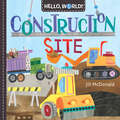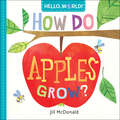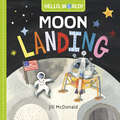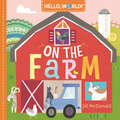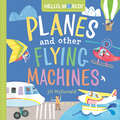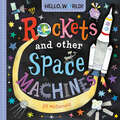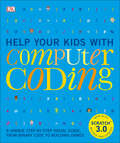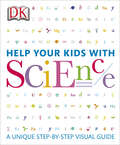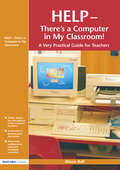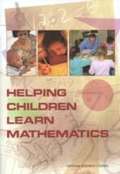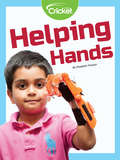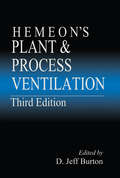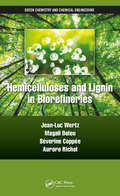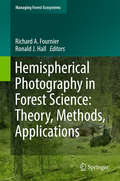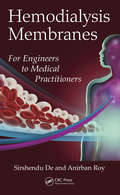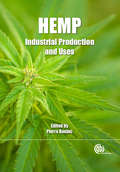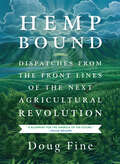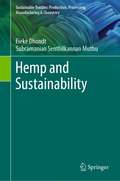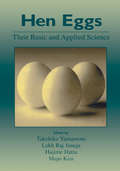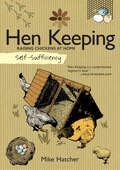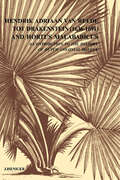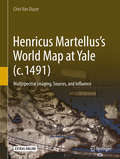- Table View
- List View
Hello, World! Construction Site (Hello, World!)
by Jill McDonaldLearn from home and explore the world with these fun and easy board books!Fans of Goodnight, Goodnight, Construction Site will love this vehicle-filled adventure in the hit Hello, World! board book series. Toddlers can learn all about the busy world of a construction site, with easy-to-understand facts about all the huge, noisy machines that captivate little ones' imaginations.Hello, World! is a series designed to introduce first nonfiction concepts to babies and toddlers. Told in clear and easy terms ("Clank! A crane is used to lift heavy things and move them to the right spot.") and featuring bright, cheerful illustrations, Hello, World! makes learning fun for young children. And each page offers helpful prompts for engaging with your child. It's a perfect way to bring science and nature into the busy world of a toddler, where learning never stops. Look for all the books in the Hello, World! series: • Solar System• Weather• Backyard Bugs• Birds• Dinosaurs• My Body• How Do Apples Grow?• Ocean Life• Moon Landing• Pets• Arctic Animals• Construction Site• Rainforest Animals• Planet Earth • Reptiles• Cars and Trucks • Music• Baby Animals• On the Farm• Garden Time• Planes and Other Flying Machines• Rocks and Minerals• Snow
Hello, World! How Do Apples Grow? (Hello, World!)
by Jill McDonaldLearn from home and explore the world with these fun and easy board books!Young children love to eat apples and go to orchards. Here's a Hello, World! board book that teaches toddlers all about how apples grow—from seed to sapling to tree to applesauce.Hello, World! is a series designed to introduce first nonfiction concepts to babies and toddlers. Told in clear and easy terms ("Apple seeds start to grow when they are planted in soil and given sunlight, water, and fresh air") and featuring bright, cheerful illustrations, Hello, World! is a perfect way to bring science, nature, and culture into the busy world of a toddler, where learning never stops.Look for all the books in the Hello, World! series: • Solar System• Weather• Backyard Bugs• Birds• Dinosaurs• My Body• How Do Apples Grow?• Ocean Life• Moon Landing• Pets• Arctic Animals• Construction Site• Rainforest Animals• Planet Earth • Reptiles• Cars and Trucks • Music• Baby Animals• On the Farm• Garden Time• Planes and Other Flying Machines• Rocks and Minerals• Snow
Hello, World! Moon Landing (Hello, World!)
by Jill McDonaldLearn from home and explore the world with these fun and easy board books!Discover all about the first moon landing with the hit nonfiction board book series Hello, World!All young children love to look up at the moon. Now here's a board book that teaches them all about the first moon landing, with easy-to-understand details about the Apollo 11 astronauts, the NASA team, spacesuits, the rocket modules, and the world's celebration after the successful mission.Hello, World! is a series designed to introduce first nonfiction concepts to babies and toddlers. Told in clear and easy terms ("An astronaut's job is to travel into space") and featuring bright, cheerful illustrations, Hello, World! is a perfect way to bring science, nature, and culture into the busy world of a toddler, where learning never stops. Look for all the books in the Hello, World! series: • Solar System• Weather• Backyard Bugs• Birds• Dinosaurs• My Body• How Do Apples Grow?• Ocean Life• Moon Landing• Pets• Arctic Animals• Construction Site• Rainforest Animals• Planet Earth • Reptiles• Cars and Trucks • Music• Baby Animals• On the Farm• Garden Time• Planes and Other Flying Machines• Rocks and Minerals• Snow
Hello, World! On the Farm (Hello, World!)
by Jill McDonaldLearn from home and explore the world with these fun and easy board books!Babies and toddlers get to visit a farm in this lively and informative addition to the hit Hello, World! board book series. Children can learn all about plants that grow, animals that help, and farmers who work hard, with easy-to-understand facts and bright pictures of rural life.Hello, World! board books introduce first nonfiction concepts to babies and toddlers. Told in clear and easy words with simple facts ("This red tractor is used for plowing, planting, and harvesting crops") and featuring bright, cheerful illustrations, Hello, World! makes learning fun for young children. It's a perfect way to bring science and nature into the busy world of a toddler, where learning never stops. Look for all the books in the Hello, World! series: • Solar System• Weather• Backyard Bugs• Birds• Dinosaurs• My Body• How Do Apples Grow?• Ocean Life• Moon Landing• Pets• Arctic Animals• Construction Site• Rainforest Animals• Planet Earth • Reptiles• Cars and Trucks• Music• On the Farm• Baby Animals
Hello, World! Planes and Other Flying Machines (Hello, World!)
by Jill McDonaldLearn from home and explore the world with these fun and easy board books!This bright and informative Hello, World! board book teaches toddlers all about planes and other machines that fly—with easy-to-understand facts about the many different ways humans can soar like birds.Hello, World! is a series designed to introduce first nonfiction concepts to babies and toddlers. Told in clear and easy terms ("The first people to fly a plane were the Wright brothers. They built their plane out of wood") and featuring bright, cheerful illustrations, Hello, World! makes learning fun for young children. And each page offers helpful prompts for engaging with your child. It's a perfect way to bring science and nature into the busy world of a toddler, where learning never stops. Look for all the books in the Hello, World! series: • Solar System• Weather• Backyard Bugs• Birds• Dinosaurs• My Body• How Do Apples Grow?• Ocean Life• Moon Landing• Pets• Arctic Animals• Construction Site• Rainforest Animals• Planet Earth • Reptiles• Cars and Trucks • Music• Baby Animals• On the Farm• Garden Time• Planes and Other Flying Machines• Rocks and Minerals• Snow
Hello, World! Rockets and Other Space Machines (Hello, World!)
by Jill McDonaldBlast off! Young astronauts can explore rockets, rovers, space shuttles, and more in this nonfiction book from the bestselling series Hello, World!Preschoolers and toddlers can learn all about the wide world of spacecraft in this cheerful and informative book—with colorful art and super-simple facts. ("A rocket flies by burning fuel and turning it into hot gas.")Told in easy-to-understand terms alongside bright illustrations of space machines and vehicles, this book makes learning easy for little ones and offers useful prompts to help adults engage with the reader on each page.It's a perfect way to bring science into the busy world of babies, toddlers, and preschoolers, where learning never stops.Look for all the books in the Hello, World! series:Solar System • Weather • Backyard Bugs • Birds • Dinosaurs • My Body • How Do Apples Grow? • Ocean Life • Moon Landing • Pets • Arctic Animals • Construction Site • Rainforest Animals • Planet Earth • Reptiles • Cars and Trucks • Music • Baby Animals • On the Farm • Garden Time • Planes and Other Flying Machines • Rocks and Minerals • Snow • Let's Go Camping • School Day • Bedtime • From Seed to Pumpkin • Rockets and Other Space Machines • Baking
Helmholtz: A Life in Science (California Studies In The History Of Science Ser. #10)
by David CahanHermann von Helmholtz was a towering figure of nineteenth-century scientific and intellectual life. Best known for his achievements in physiology and physics, he also contributed to other disciplines such as ophthalmology, psychology, mathematics, chemical thermodynamics, and meteorology. With Helmholtz: A Life in Science, David Cahan has written a definitive biography, one that brings to light the dynamic relationship between Helmholtz’s private life, his professional pursuits, and the larger world in which he lived. ? Utilizing all of Helmholtz’s scientific and philosophical writings, as well as previously unknown letters, this book reveals the forces that drove his life—a passion to unite the sciences, vigilant attention to the sources and methods of knowledge, and a deep appreciation of the ways in which the arts and sciences could benefit each other. By placing the overall structure and development of his scientific work and philosophy within the greater context of nineteenth-century Germany, Helmholtz also serves as cultural biography of the construction of the scientific community: its laboratories, institutes, journals, disciplinary organizations, and national and international meetings. Helmholtz’s life is a shining example of what can happen when the sciences and the humanities become interwoven in the life of one highly motivated, energetic, and gifted person.
Help Your Kids with Computer Coding: A Unique Step-by-Step Visual Guide, from Binary Code to Building Games (DK Help Your Kids)
by DKDon't just play computer games with your kids—build them! All you need is a desktop or laptop with Adobe 10.2 or later, and an internet connection to download Scratch 2.0 and Python 3. Coding with Scratch can be done without download on https://scratch.mit.edu.Help Your Kids with Computer Coding is a straightforward, visual guide to helping kids understand the basics of computer coding using Scratch and Python coding languages. Essential coding concepts like scripts, variables, and strings are explained using build-along projects and games.Kids can create online games to play like Monkey Mayhem and Bubble Blaster, draw mazes and shapes, build animations, and more using the step-by-step examples to follow and customize. Seven projects let kids—and their parents—practice the skills as they are learning in each section of the book. Kids get instant results, even when completely new to coding.Packed with visual examples, expert tips, a glossary of key terms, and extras such as profiles of famous coders, Help Your Kids with Computer Coding lays a hands-on foundation for coding so adults and kids can learn together.Supporting STEM education initiatives, computer coding teaches kids how to think creatively, work collaboratively, and reason systematically, and is quickly becoming a necessary and sought-after skill. DK's computer coding books are full of fun exercises with step-by-step guidance, making them the perfect introductory tools for building vital skills in computer programming. Series Overview: DK's bestselling Help Your Kids With series contains crystal-clear visual breakdowns of important subjects. Simple graphics and jargon-free text are key to making this series a user-friendly resource for frustrated parents who want to help their children get the most out of school.
Help Your Kids with Science: A Unique Step-by-Step Visual Guide (DK Help Your Kids)
by DKIf you&’re left blinded by science, this ultimate study aid makes everything clear. This unique visual reference guide adopts a simple step-by-step approach to give you a complete understanding of this diverse and difficult subject. Bubbling over with pictures, diagrams, and information, this book covers biology, chemistry, and physics in comprehensive depth and detail. Help Your Kids with Science encourages parents and children to work together as a team to solve even the most challenging problems on the school syllabus. The reference section also includes a glossary of key scientific terms and symbols. With your support, children can gain a complete understanding of science, leaving them calm, confident, and exam ready. Series Overview: DK's bestselling Help Your Kids With series contains crystal-clear visual breakdowns of important subjects. Simple graphics and jargon-free text are key to making this series a user-friendly resource for frustrated parents who want to help their children get the most out of school.
Help--There's a Computer in My Classroom!
by Alison BallMastering basic computer skills can be a daunting task for any busy teacher. This book provides a solution with simple instructions backed up by pictures of what the computer screen should look like at each stage of an activity. Use this book to: find out what your computer can do; save and organise work on your computer; create activities for chil
Helping Children Learn Mathematics
by Mathematics Learning Study CommitteeFor our youth to succeed, we need to change how we require teaching mathematics. Helping Children Learn Mathematics provides comprehensive and reliable information that will guide efforts to improve school mathematics from pre-kindergarten through eighth grade. The authors discuss the major changes that need to be made in mathematics instruction, instructional materials, assessments, teacher education, and the broader educational system.
Helping Hands
by Elizabeth PrestonSome kids are born missing a hand or fingers, others lose them because of accidents. Find out how people are printing artificial hands on 3-D printers to help those who need a hand. They are cheap, easy to build, and really work!
Helping Stop Hitler's Luftwaffe: The Memoirs of a Pilot Involved in the Development of Radar Interception, Vital in the Battle of Britain
by Arthur McDonaldAn RAF pilot recounts his vital role in the development of Britain’s WWII air defense system in this fascinating military memoir.During the 1930s, the UK had no realistic defense against fast-flying bomber planes. That was before radar technology proved capable of detecting an aircraft before it even reached British soil. This was shown in dramatic fashion during the Biggin Hill Experiment, when a young Arthur McDonald led three biplanes—all directed by radar sets on the ground—to intercept incoming aircraft. McDonald was told, “the whole future of this country depends on the results which you obtain.” His success led to a new military strategy focused on modern fighter planes using a newly developed radar network—all of which proved crucial during the Battle of Britain. For his work, McDonald received the Air Force Cross.In this enlightening autobiography, Air Marshal Sir Arthur McDonald describes those early radar experiments as well his other innovation, the Duxford flare path, designed to be visible to landing aircraft but not to enemy attackers. McDonald went on to hold many senior posts in the RAF before retiring in 1962. But it his part in the development of Britain’s air defense at the most crucial time in its history for which he will always be remembered.
Hemeon's Plant & Process Ventilation
by D. Jeff BurtonIndustrial hygienists and ventilation engineers know the name well: W.C.L. Hemeon. Since 1955, those professionals have frequently looked to Hemeon's Plant & Process Ventilation for essential information on industrial ventilation. Hemeon's longtime influence and inspiration has now prompted D. Jeff Burton-a prolific author on industrial ventilation himself-to produce a Fourth Edition of "the classic industrial ventilation text."While retaining Hemeon's distinctive writing style, conveying practical information in vivid phrasing, Burton has added extensive new information to recognize today's technology and techniques.Essential fundamentals of ventilation covered in the book include an explanation about the dynamic properties of airborne contaminants, and the principles of dispersion mechanism and local exhaust. Advanced applications are also examined in detail, particularly system design, dust control, and troubleshooting.Along with providing essential background on the two primary types of workplace ventilation-general and local exhaust-Hemeon's Plant & Process Ventilation also aims for mutual understanding between the health-oriented priorities of industrial hygienists, and the practical applications for maximum efficiency considered by ventilation engineers.Have a well-thumbed, dog-eared copy of Hemeon's Plant & Process Ventilation? Now is the best time to retire it in favor of this revised-and respectful-edition. Those who are new to Hemeon's approach will discover what other professionals have known more than 40 years: Hemeon offers some of the most effective ways to control environmental contaminates through proper ventilation techniques.
Hemicelluloses and Lignin in Biorefineries (Green Chemistry and Chemical Engineering)
by Jean-Luc Wertz Magali Deleu Séverine Coppée Aurore RichelHemicelluloses and Lignin in Biorefineries provides an understanding of lignocellulosic biomass, which is mainly composed of cellulose, hemicelluloses, and lignin. It promotes the valorization of these molecules in the context of the bioeconomy and presents hemicelluloses and lignin, which are generated in lignocellulosic biorefineries, as the molecules of the future. The viability of these molecules lies in their renewability and potential. This book covers all aspects of hemicelluloses and lignin including structure, biosynthesis, extraction, biodegradation, and conversion. The book also looks ahead to the socioeconomic and environmental value of biobased industry and emphasizes an understanding of the potential of lignocellulosic biomass.
Hemispherical Photography in Forest Science: Theory, Methods, Applications
by Richard A. Fournier Ronald J. HallThis book presents practical information about hemispherical photography from the perspectives of field data acquisition, image processing and information retrieval methods. This book is organized into three sections. The first section describes what is hemispherical photography and what are the fundamental elements of forest structure and light interactions within the forest canopy. The second section provides practical information about the equipment, procedures and tools for procuring, processing and analyzing hemispherical photographs. Armed with this information, the third section describes several applications of hemispherical photographs to forestry and natural resource assessment. The book concludes with a discussion about modelling tools and future directions of this rapidly growing field. There is currently no information source on the market that has this comprehensive range of topics combined in a single book. The book will appeal to academics, graduate students, natural resource professionals and researchers alike.
Hemodialysis Membranes: For Engineers to Medical Practitioners
by Sirshendu De Anirban RoyBook initiates with introductory material to hemodialysis technology and its historical evolution and later on divulging into the field of biomaterials. With this background, the book discusses selection criteria of a suitable biomaterial for synthesis of haemodialysis membranes along with illustration of a complete indigenous, low cost technology for spinning of haemodialysis fibres. <P><P>Well illustrated description of instruments used for membrane characterization and biomedical engineering is also provided at suitable junctures to effectively present the concept including worked out examples. Present title can be a good textbook as well as a research material for membrane as well as biomedical engineering curricula and provides coverage for appropriate undergraduate and graduate students interested in hemodialysis membranes.
Hemp
by Laurent Arnaud Pierre Bouloc Serge AllegretHemp production for industrial purposes continues to grow worldwide, and is currently being used for many applications including house insulation, paper making, animal bedding, fabric, rope making and also as a biofuel. This book brings together international experts to examine all aspects of industrial hemp production, including the origins of hemp production, as well as the botany and anatomy, genetics and breeding, quality assessment, regulations, and the agricultural and industrial economics of hemp production. A translation of Le Chanvre Industriel, this book has been revised and updated for an international audience and is essential reading for Producers of industrial hemp, industry personnel and agriculture researchers and students.
Hemp Bound: Dispatches from the Front Lines of the Next Agricultural Revolution
by Doug Fine"Doug has created a blueprint for the America of the future.&”—Willie NelsonThe stat sheet on hemp sounds almost too good to be true: its fibers are among the planet&’s strongest, its seed oil the most nutritious, and its potential as an energy source vast and untapped. Its one downside? For nearly a century, it&’s been illegal to grow industrial cannabis in the United States–even though Betsy Ross wove the nation&’s first flag out of hemp fabric, Thomas Jefferson composed the Declaration of Independence on it, and colonists could pay their taxes with it. But as the prohibition on hemp&’s psychoactive cousin winds down, one of humanity&’s longest-utilized plants is about to be reincorporated into the American economy. Get ready for the newest billion-dollar industry.In Hemp Bound: Dispatches from the Front Lines of the Next Agricultural Revolution, bestselling author Doug Fine embarks on a humorous yet rigorous journey to meet the men and women who are testing, researching, and pioneering hemp&’s applications for the twenty-first century. From Denver, where Fine hitches a ride in a hemp-powered limo; to Asheville, North Carolina, where carbon-negative hempcrete-insulated houses are sparking a mini housing boom; to Manitoba where he raps his knuckles on the hood of a hemp tractor; and finally to the fields of east Colorado, where practical farmers are looking toward hemp to restore their agricultural economy—Fine learns how eminently possible it is for this misunderstood plant to help us end dependence on fossil fuels, heal farm soils damaged after a century of growing monocultures, and bring even more taxable revenue into the economy than its smokable relative.Fine&’s journey will not only leave you wondering why we ever stopped cultivating this miracle crop, it will fire you up to sow a field of it for yourself, for the nation&’s economy, and for the planet.
Hemp and Sustainability (Sustainable Textiles: Production, Processing, Manufacturing & Chemistry)
by Subramanian Senthilkannan Muthu Fieke DhondtThis book highlights the positive and negative impacts that hemp fibre and textiles have on environment, while studying the effects of climate change on the growth of fibre hemp. Human-induced climate change challenge the availability of textile fibres, whereas today’s apparel industry leaves behind a substantial environmental footprint. Sustainable hemp textiles can lighten it. The book describes the environmental impact of hemp and how climate change influences future hemp growth. Hemp is considered in most literature as a sustainable alternative for the commonly used fibres polyester and cotton. However, most research does not go farther than the environmental impacts of hemp, and there is currently a lack of knowledge/literature that examines the possibilities of hemp growth under changing climate conditions.
Hemp: Industrial Production and Uses
by Pierre BoulocHemp production for industrial purposes continues to grow worldwide, and is currently being used for many applications including house insulation, paper making, animal bedding, fabric, rope making and also as a biofuel. This book brings together international experts to examine all aspects of industrial hemp production, including the origins of hemp production, as well as the botany and anatomy, genetics and breeding, quality assessment, regulations, and the agricultural and industrial economics of hemp production. A translation of Le Chanvre Industriel, this book has been revised and updated for an international audience and is essential reading for Producers of industrial hemp, industry personnel and agriculture researchers and students.
Hen Eggs: Basic and Applied Science
by Takehiko Yamamoto Lekh Raj Juneja Hajime Hatta Mujo KimThe egg is a chemical storehouse-within an incubating egg a complicated set of chemical reactions take place that convert the chemicals into a living animal. Using hen eggs as a model, this new text explores the use of eggs for food, industrial, and pharmaceutical applications. It covers the chemistry, biology, and function of lipids; carbohydrates; proteins; yolk antibody (IgY); and other materials of eggs. The novel merits of egg materials over others used in the same products are also discussed. These areas of egg technology have never been compiled before in one source.
Hen Keeping: Raising Chickens at Home (Self-Sufficiency)
by Mike HatcherA beginner&’s guide to keeping hens with info on over fifty breeds, plus housing, feeding, daily care, disease prevention, egg production, breeding, & more. Self-sufficiency and organic living have never been more prevalent than in recent years. Keeping hens is becoming increasingly popular and is one way of ensuring you have fresh produce at your fingertips. This authoritative book introduces some of the key aspects of keeping your own chickens and benefitting from the produce. You don&’t need a large garden to keep poultry, and an average family only needs a couple of hens to keep them well stocked in fresh eggs all year round. The set-up costs are minimal, and you don&’t need a whole host of expensive gadgets or equipment to get started or care for your chickens. Packed with useful information on poultry keeping (housing, food and water, daily care routines, disease prevention and cure, encouraging egg production, and breeding), this guidebook also features comprehensive information on breeds and a useful list of contacts.&“This book provides a good starting place to ensure that you have everything you need to know at your fingertips . . . If your aim is to keep hens for their eggs on a small-scale, then Self-Sufficiency: Hen Keeping should be at the top of your to-read list.&” —The Rural
Hendrik Adriaan Van Reed Tot Drakestein 1636-1691 and Hortus, Malabaricus
by J. HenigerThis text is a reference work for botanists studying the flora of South Asia. As commander of Malabar, van Reed was responsible for compiling the Hortus Malabaricus, a major publication of the flora and medical use of plants.
Henricus Martellus’s World Map at Yale: Multispectral Imaging, Sources, and Influence (c. #1491)
by Chet Van DuzerThis book presents groundbreaking new research on a fifteenth-century world map by Henricus Martellus, c. 1491, now at Yale. The importance of the map had long been suspected, but it was essentially unstudiable because the texts on it had faded to illegibility. Multispectral imaging of the map, performed with NEH support in 2014, rendered its texts legible for the first time, leading to renewed study of the map by the author. This volume provides transcriptions, translations, and commentary on the Latin texts on the map, particularly their sources, as well as the place names in several regions. This leads to a demonstration of a very close relationship between the Martellus map and Martin Waldseemüller’s famous map of 1507. One of the most exciting discoveries on the map is in the hinterlands of southern Africa. The information there comes from African sources; the map is thus a unique and supremely important document regarding African cartography in the fifteenth century. This book is essential reading for digital humanitarians and historians of cartography.
